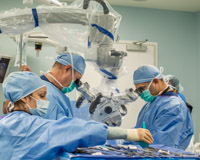When you hear the words “spine surgery,” it’s natural to assume it’s the next step after a diagnosis of back pain or a spinal condition. But according to Brandon Hirsch, MD, spine spine surgeon at DISC Sports & Spine Center, surgery is rarely the first option. In fact, many patients can find significant relief with less invasive, conservative treatments like physical therapy, targeted spinal injections, stretching programs and medication.
VIDEO: Brandon Hirsch, MD on Non-Surgical Treatments
This patient-first philosophy means our spine specialists at DISC will look at the whole picture, including your symptoms, your imaging, lifestyle, and your goals before deciding if surgery is truly necessary.
As Dr. Hirsch put it: “When meeting a new patient, my approach is to do everything possible to treat that patient before recommending surgery. If those things are failing to provide adequate relief, and there's a good surgical option available, then that's when I would recommend we discuss the possibilities of a surgical intervention.”
Do I Need Spine Surgery?
One of the first questions many patients have when they see a spine specialist is: “Do I need surgery?” The answer, for most people, is no, at least not right away.

DISC doctors use a straightforward approach: before even discussing surgery, they will focus on exhausting all conservative treatment options. This begins with a thorough evaluation, which often includes:
- Imaging studies such as X-rays, MRIs, or occasionally CT scans to better understand the condition of your spine.
- Detailed physical exams to assess strength, mobility and pain triggers.
- Lifestyle and activity assessments to understand how your pain impacts your daily life.
Once this full diagnostic picture is built, the conversation often turns toward non-surgical options that can reduce pain, improve function and help you return to normal activities.
 “One of the advantages of working in a multidisciplinary surgery center is that we don’t have to make treatment decisions in a vacuum. If a patient comes in with what seems like a minor or moderate spine condition, I can walk down the hall, talk to one of our pain specialist, and discuss non-surgical options. That way, we’re not just treating the spine, we’re looking at the patient’s total health and tailoring the plan to what will truly help them long-term.”
“One of the advantages of working in a multidisciplinary surgery center is that we don’t have to make treatment decisions in a vacuum. If a patient comes in with what seems like a minor or moderate spine condition, I can walk down the hall, talk to one of our pain specialist, and discuss non-surgical options. That way, we’re not just treating the spine, we’re looking at the patient’s total health and tailoring the plan to what will truly help them long-term.”
Mark Liker MD, FAANS, FACS
Board-Certified Neurosurgeon
Minimally Invasive Spine Surgery
Common Non-Surgical Treatments for Back Pain
Many back problems, ranging from herniated discs to degenerative changes, can improve without surgery. Here are some of the most common first-line treatments your DISC care team may recommend:
Physical Therapy:
A customized exercise program can strengthen the muscles that support your spine, improve flexibility and relieve pressure on irritated nerves. A physical therapist will also teach you techniques to move safely and prevent future injuries.
Stretching and Mobility Exercises:
Targeted stretches can improve spinal flexibility and reduce muscle tightness, both of which are common contributors to back pain.
 Medications:
Medications:
Over-the-counter anti-inflammatory drugs, prescription pain relievers or muscle relaxants may be used to reduce pain and swelling so you can move more comfortably.
Epidural Steroid Injections:
In certain cases, injections of anti-inflammatory medication around the spinal nerves can help calm pain, especially if it radiates down the arms or legs.
These treatments are often used in combination for the best results — and for many patients, they’re enough to avoid surgery altogether.
 “For a lot of patients with back pain, especially those without severe structural damage, conservative treatments like physical therapy, mobility work, and targeted home exercises can deliver lasting relief. These approaches restore strength, improve flexibility, and help stabilize the spine, allowing many people to return to normal life without invasive procedures.”
“For a lot of patients with back pain, especially those without severe structural damage, conservative treatments like physical therapy, mobility work, and targeted home exercises can deliver lasting relief. These approaches restore strength, improve flexibility, and help stabilize the spine, allowing many people to return to normal life without invasive procedures.”
Alexander Hersel, MD
Interventional Pain Management
Anesthesiologist
How Do You Know When You Need Spine Surgery?
While conservative care is the first step, there are situations where surgery becomes the right choice. Dr. Hersel emphasizes that surgery is only recommended when:
- Conservative treatments have failed. You’ve tried physical therapy, medication, and other non-invasive methods without significant improvement.
- There’s a clear surgical solution. Imaging and your symptoms align with a condition that surgery can realistically and reliably address.
- Your quality of life is significantly impacted. Pain, weakness, or numbness may be preventing you from working, exercising, or performing daily activities.
- There’s a risk of worsening damage. Severe nerve compression or spinal instability can lead to permanent deficits if not treated surgically.
It’s important to remember that spine surgery is not a last resort out of desperation, it’s a carefully considered option designed to correct a specific problem when other measures haven’t worked.
What to Expect If Spine Surgery Is Recommended
If you reach the point where surgery is appropriate, your specialist will discuss all your options in detail, including the expected outcomes, recovery process, and potential risks.
Thanks to advancements in minimally invasive spine surgery, many procedures now involve smaller incisions, less disruption to surrounding tissue, and faster recovery times compared to traditional open surgery. Some patients are even able to go home the same day through DISC’s same-day spine consultation program.
But even in these cases, the goal is the same: only proceed when the benefits clearly outweigh the risks and when surgery offers a high likelihood of meaningful improvement.

“While many patients with back pain never need surgery, there comes a point, after exhausting more conservative options, when it’s appropriate to start that conversation. And even then, modern spine surgery is often far less invasive than people expect, with techniques that minimize tissue disruption, speed recovery, and get patients back to their lives sooner. At DISC, we perform these procedures in an outpatient setting, which means smaller incisions, faster recovery, and going home the very same day.”
Travis Ladner, MD
Neurosurgeon
Minimally Invasive Spine Surgery
Why a Conservative Approach Works
As Dr. Bradley Spiegel explained, "Spine conditions can be complex, and the body often has an impressive ability to heal given the right support. Jumping straight to surgery can mean taking on unnecessary risks when a non-surgical plan could have been equally effective."
By starting with conservative treatments, patients:
- Avoid unnecessary procedures that may not improve their condition.
- Gain tools for long-term spine health such as exercises and posture techniques.
- Allow time for the body to recover naturally without surgical intervention.
In other words, patience, persistence, and the right treatment plan can often lead to lasting relief without the need for an operating room.
If you’re living with back pain, don’t assume surgery is inevitable. The multidisciplinary team at DISC Sports & Spine Center believes in a comprehensive, patient-first approach that prioritizes your long-term health. Most patients benefit from a well-designed, non-surgical conservative treatment plan before ever considering surgery.
When surgery is necessary, it’s chosen deliberately and only after other options have been exhausted and when the benefits are clear. This approach ensures that every patient gets the right treatment at the right time.
If you’re struggling with back pain and would like to learn more about your options, schedule a consultation at DISC today.

About the author
discmdgroup DISC Sports & Spine Center (DISC) is a national leader in minimally invasive spine surgery, orthopedic surgery, and sports medicine care. Our spine surgeons set the standard in artificial disc replacement, spine fusion, discectomy, microdiscectomy and the full spectrum of spine procedures. The group’s orthopedic surgeons advance the state of joint preservation surgery and total joint replacement, including total knee replacement as well as total hip replacement. Our flagship surgery centers based in Newport Beach, Marina del Rey, and Carlsbad serve patients local to Los Angeles, Orange County and San Diego, as well as the rest of the country. Read more articles by discmdgroup.










